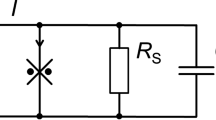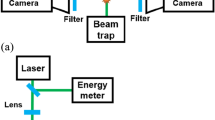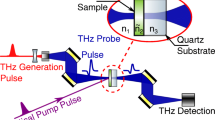Abstract
We report on precise drift velocity measurements of electrons and holes in 50 mK, ultrapure (≈1010 net shallow impurities per cm3) germanium 〈100〉 CDMS dark matter detectors as a function of electric field up to 4 V/cm. A laser diode connected to an optical fiber extending from room-temperature to the detector creates electron-hole pairs on one surface of the crystal. High-speed electronics measure the drift current as the generated carriers travel to the opposite face of the crystal.
CDMS detectors measure the ionization and phonon response of particle interactions within the crystal. Stable charge collection is necessary for successful background discrimination when looking for a possible dark matter signal. While biased, however, ionization performance degrades over time due to the build-up of space charge. Free electrons and holes created by particle interactions are subject to drift-diffusion dynamics occurring simultaneously with the trapping of carriers to localized surface and bulk states. The combination of these processes determine the evolution of space charge within the crystal, making it important that we understand carrier transport under our unique operating condition of low-temperature and low-field. We find good agreement between our measured drift velocities and our theoretical predictions, indicating carrier scattering is dominated by spontaneous phonon emission. In addition, we present preliminary measurements of effective longitudinal carrier trapping lengths for both n-type and p-type crystals at 50 mK.



Similar content being viewed by others
References
Z. Ahmed et al., Science 327, 1619 (2010)
Z. Ahmed et al., Phys. Rev. Lett. 106, 131302 (2011)
K.M. Sundqvist, B. Sadoulet, J. Low Temp. Phys. 151, 443 (2008)
K.M. Sundqvist et al., AIP Conf. Proc. 1185, 128 (2009)
C.N. Bailey et al., J. Low Temp. Phys. 151, 211 (2009)
K.M. Sundqvist, Carrier transport and related effects in the detectors of the cryogenic dark matter search. Ph.D. Thesis, University of California, Berkeley (2011)
M.V. Fischetti, S.E. Laux, J. Appl. Phys. 80, 2234 (1996)
V. Aubry-Fortuna, A. Broniatowski, P. Dollfus, AIP Conf. Proc. 1185, 635 (2009)
V. Aubry-Fortuna, P. Dollfus, J. Appl. Phys. 108, 123706 (2010)
T. Shutt et al., Phys. Rev. Lett. 69, 3531 (1992)
T. Shutt, A dark matter detector based on the simultaneous measurement of phonons and ionization at 20 mK. Ph.D. Thesis, University of California, Berkeley (1993)
R. Newman et al., in Solid State Physics, vol. 8, ed. by F. Seitz, D. Turnbull (Academic Press, New York, 1959), p. 49
Acknowledgements
This work is sponsored by the United States Department of Energy under grant DE-AC02-76SF00515 and by the National Science Foundation under awards 0705052, 0902182, 1004714, and 0802575. We are grateful for their continuing support.
Author information
Authors and Affiliations
Corresponding author
Additional information
For the SuperCDMS collaboration.
Rights and permissions
About this article
Cite this article
Phipps, A., Sundqvist, K.M., Lam, A. et al. Optically Induced Measurement of Electron and Hole Drift Velocities in a Germanium 〈100〉 CDMS Detector at 50 mK. J Low Temp Phys 167, 1112–1118 (2012). https://doi.org/10.1007/s10909-012-0472-3
Received:
Accepted:
Published:
Issue Date:
DOI: https://doi.org/10.1007/s10909-012-0472-3




